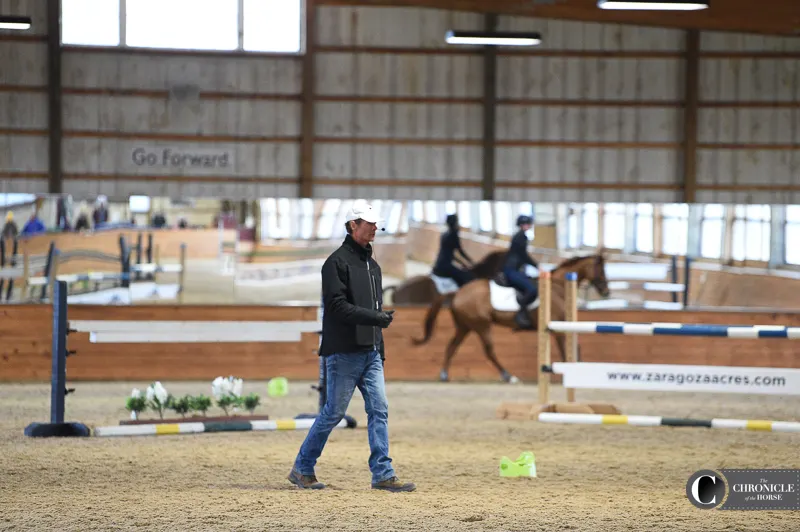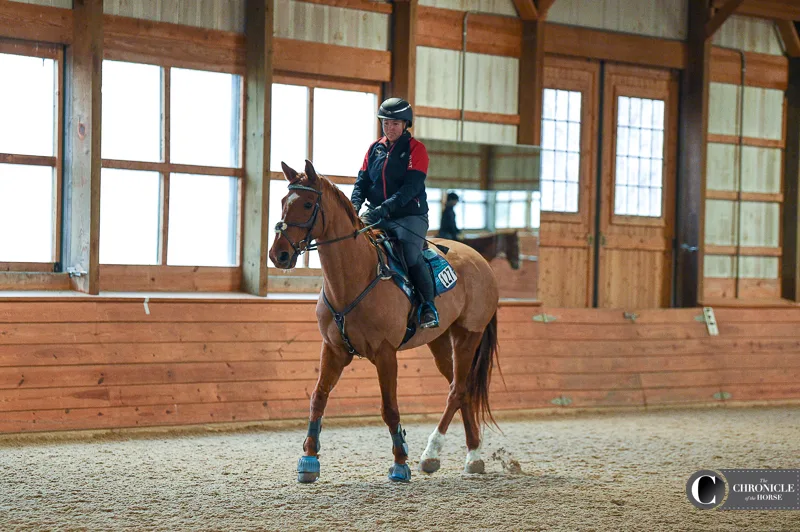How disciplined are you in your riding?
Can you maintain straightness down a line of jumps—leaving the ground perfectly in the middle of each fence? Can you execute inside turns without becoming jerky or losing impulsion? Will your horse come to a halt between fences, before cantering off softly to the next fence a few strides away?
Those were the principles explored during the second day of William Fox-Pitt’s Virginia clinic, held March 9-10. Weather forced organizers to switch the show jumping and cross-country sessions, so after starting outdoors on Day 1, show jumping practice took place on Day 2 in the indoor arena at Sprieser Sporthorse in Marshall, Virginia.

William Fox-Pitt discusses what he wants riders to do during their flatwork. Kimberly Loushin Photos
And while the exercises he put the horses and riders through focused on developing a more rideable horse, his cross-country refrain of “rhythm and balance” was repeated throughout the day.
“We’re working the horse, our eye, our control,” he said. “It’s not always about the height. It’s about the discipline.”
Fox-Pitt wanted riders to think about establishing responsiveness in their horses during their warm-up on the flat. He didn’t want them to find a quiet rhythm and just tootle along, but keep making transitions between and within the gaits and ask for more bend than they would ask for in the show ring.
“I really want you to put them to work now,” he said. “I want them to start listening to you. Ask them questions. You can ask for as much bend as you think they can do. You can ask them sometimes how slow can you go with a slow trot or a slow canter. Really have self-carriage. Obviously the younger horses won’t be able to do that very much, but just ask the question, ‘How much can you do?’ That way, in the long run, you improve. By pushing the limits very nicely, they gradually improve.”
Kimberly Loushin Videos
After the flat warm-up, he directed riders to trot a few fences, just as they’d done on cross-country day, to tune into and sharpen their footwork. As on the previous day, the fences were low enough that any horse who refused was not allowed to circle, but had to jump from where it had stopped.
“If things are going to go wrong, they’re going to go wrong in trot,” he said. “We need to do it anyway. My top level horse might do an entire session in trot. They’re working on their footwork.”
The first jumping exercise involved cantering down a long line (roughly eight or nine strides) set along the rail. Fox-Pitt didn’t care how many strides riders got the first time down the line. He wanted them to count how many strides they took, because the next time they cantered through, he asked them to add at least two strides.
ADVERTISEMENT
To make the task more challenging, he didn’t want them to compress the canter heading to the first fence; he wanted them to maintain a normal canter and then shorten the stride between fences, while maintaining straightness.
“I want it in a civilized, straight line, not spaghetti,” he said.
Then Fox-Pitt added a second challenge: Jump into the line, halt (without trot steps) halfway to the second fence, pick up a prompt canter to jump out, then halt again on the back side of the second fence. On the opposite long side, riders repeated the exercise over a single oxer, halting several strides before it, cantering the fence and halting in a straight line afterwards.
“It’s nice to jump a parallel [oxer] after the halt. They have to try harder,” he said. “Just because it’s bigger, they don’t have to go faster.”
Not only did this test whether the riders could bring their horse back, but also if they could immediately develop a good canter to jump just a few strides later. Fox-Pitt was a stickler for using the leg to get the horse coming forward, saying, “Stop clucking like a chicken and [use] leg.”
He also reminded them to keep their upper body back and quiet on the way to the fence.
“Have a soft enough canter in your waiting,” he told one rider. “Don’t clamp in your waiting.”
Fox-Pitt’s next exercise involved doing a series of rollbacks over four fences. He set plastic markers in the arena, and on their first time through riders were instructed to turn on the outside of those markers. The second time through they had to execute the turn inside. As the riders navigated the exercise, he reminded them to keep the horse jumping straight and to find the center of each fence.
“Even if you have the pressure of time [in a round], don’t contort the body,” he said.
He was strict in telling the riders not to do a simple change if their horse landed on the wrong lead, but to “kick on” and to use their leg aids and eyes to help the horse land the correct lead at the next fence.
“It’s interesting how making your lives a bit tougher is making you guys a bit better,” he told the training/prelim group. “It was noticeably better than the easier route. You had to leg on and get going.”
ADVERTISEMENT
Next the riders moved onto coursework, with emphasis on bending lines. Once again Fox-Pitt was unconcerned about how many strides they got between fences; instead he prioritized riding a consistent rhythm and balance. When one line rode consistently long, he reminded riders that it was their leg, not their upper body that closed the distance and made it easier for the horse.
“It’s riding long, so it’s good when it’s long not to [lean at the fence],” he said. “Everyone is holding their balance. Grow yourself over the fence.”
Troubleshooting On The Flat
In the intermediate groups, a couple of the horses showed tenseness on the flat, something Fox-Pitt said was important to address early in the horse’s upper level career.
“He’s got a tight body. He’s jagged and spikey; we’ve got to make him more malleable,” he told one rider, encouraging her to stay off her horse’s back in the canter to encourage him to keep taking forward, fluid steps rather than shortening his stride and getting stabby in his steps.
For another, he recommended his “slow, low and go” theory.
“When the head comes up and everything comes tight, slow her down, put her head down, and then reward her by going forward,” he said. “I call it slow, low, go because then you’ll remember that. It’s a good training tool because it becomes a habit. They know when they come up, tight, it’s going to be low, low, go, that’s their way through it, and they learn to look for it.”
When one of Chris Talley’s horses had the tendency to bend too much to the inside and shorten the neck, Fox-Pitt told him to put both reins in his outside hand to aid with straightness. With time, he said, the technique would encourage the horse to lengthen her neck as well.
“When you ride with one hand, the horse is not overbent,” he said. “Our inside hand overbends our horses, not our outside hand. Again, you want softness; you want roundness. You don’t mind her being a bit low to the bit. You don’t want her too round; you don’t want her short or behind the bit. When you ride with one hand like that, she’s never behind the bit and the contact, and for the moment she looks quite nice and soft.”
This is the second day of the William Fox-Pitt clinic. You can read about Day 1’s lesson on rhythm and balance as the guiding tenets of cross-country riding here.
















